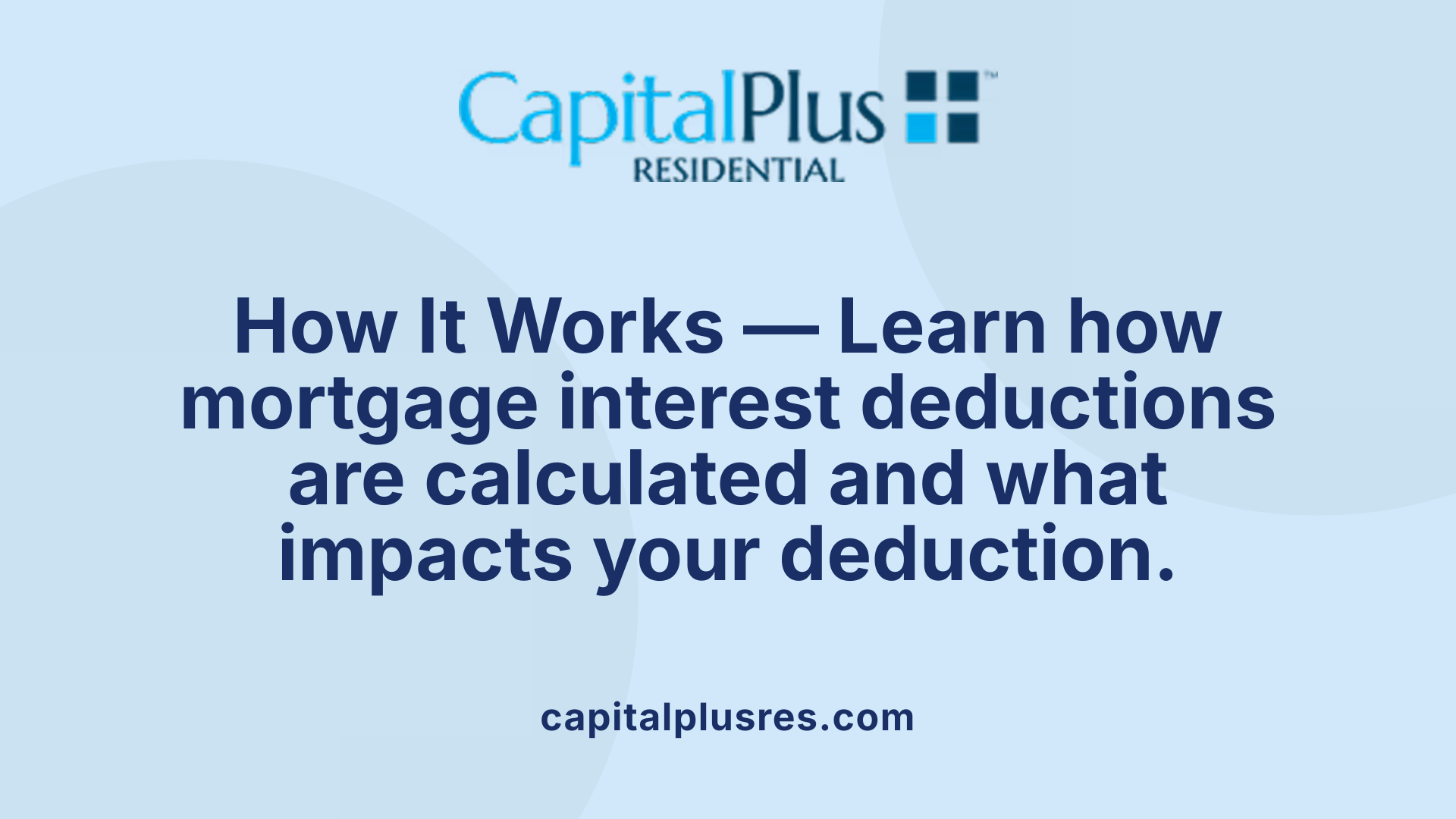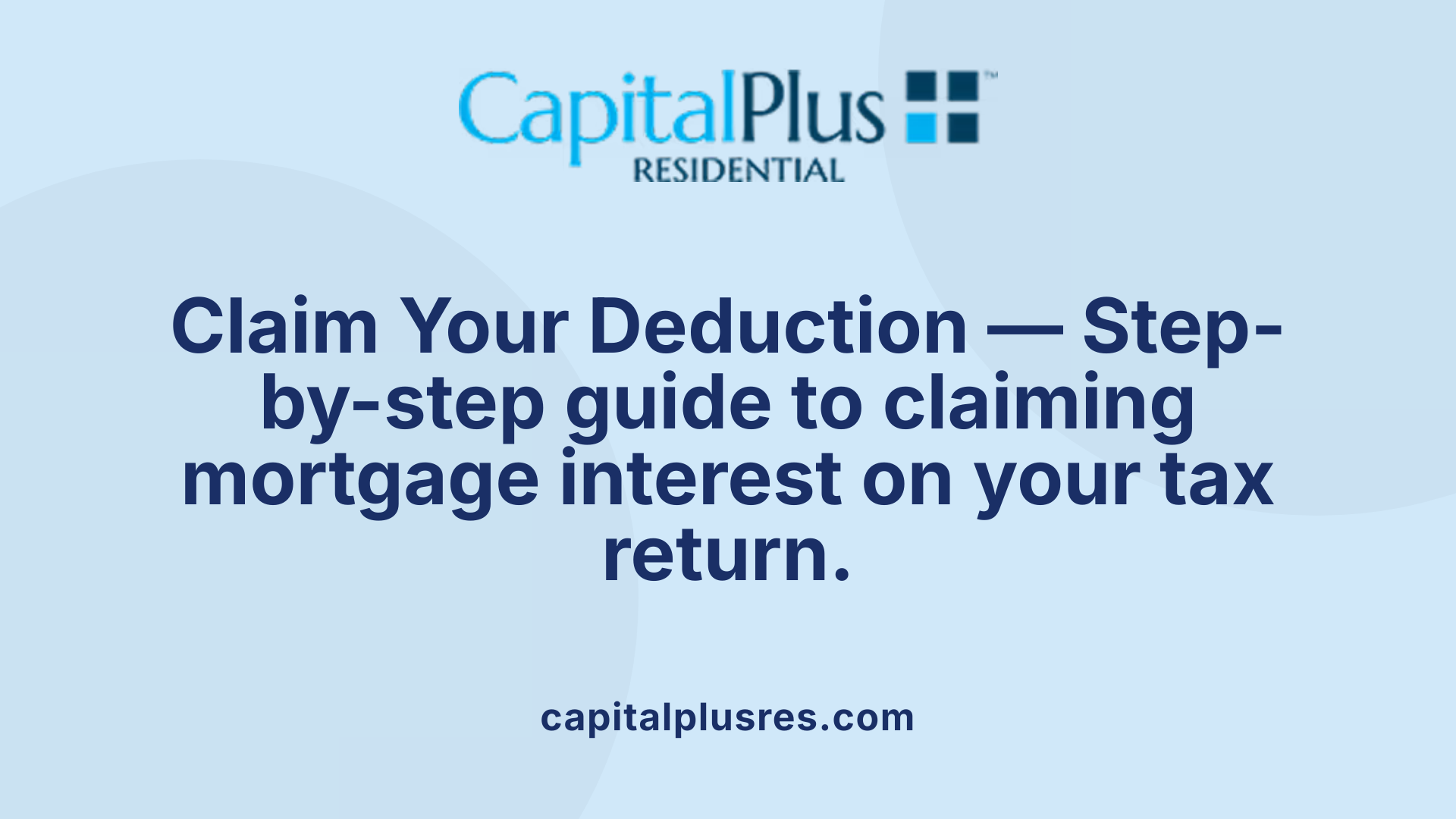An Introduction to Mortgage Interest Deductions
Mortgage interest deductions offer a significant tax benefit for eligible homeowners, reducing taxable income through the deduction of interest paid on loans used to finance a primary or secondary residence. This article explores the mechanics, eligibility, legal framework, and recent legislative changes shaping this key component of the U.S. tax system.
The Mechanics of Mortgage Interest Deductions

How mortgage interest deductions are calculated
Mortgage interest deductions enable taxpayers to lower their taxable income by the amount of interest paid on permitted home loans. This calculation begins with the mortgage interest paid, which is summarized on Form 1098 provided by the lender at the end of each year.
Taxpayers can deduct the interest only if they itemize their deductions on Schedule A of Form 1040. The deduction's value depends on the amount of interest paid, which, in turn, hinges on the size of the mortgage, the interest rate, and how long the loan has been outstanding.
The IRS establishes a limit on the amount of mortgage debt eligible for deduction. For mortgages taken out after December 15, 2017, interest is deductible on home loans up to $750,000. For older loans—those incurred before this date—the limit was higher, up to $1 million. This cap influences how much interest can be effectively deducted each year.
Points paid on the mortgage, essentially prepaid interest, may also be deducted either over the loan’s life or immediately if certain criteria are met. The total deduction can be affected by other charges like late payments or prepayment penalties, provided they are related to the mortgage interest.
In summary, the IRS's rules, including documentation via Form 1098 and the choice to itemize deductions, determine how much mortgage interest a taxpayer can deduct, with limits set according to the date of the mortgage origin.
Requirements for qualifying loans
To qualify for a mortgage interest deduction, several criteria must be met. The loan must be secured by the home, meaning it is backed by the property as collateral. The property can be a primary residence or a second home.
The loan proceeds must have been used to buy, build, or substantially improve the property—interest on loans used solely for personal expenses or investment properties generally does not qualify.
The home must contain sleeping, cooking, and toilet facilities as part of the dwelling, affirming its status as a residence.
In addition, taxpayers need to receive Form 1098 from their lender, which details the interest paid. Only by itemizing deductions using Schedule A can the mortgage interest be claimed. Moreover, the mortgage must meet the IRS criteria for being considered a qualified debt, which involves the loan being in a sufficient security agreement.
Interest on mortgages for rental properties or loans used for non-qualified purposes is usually not deductible under this provision. Understanding these constraints helps taxpayers correctly determine their eligibility for the deduction.
Impact of mortgage debt limits
The amount of mortgage debt on which interest is deductible has been regulated to prevent excessive tax benefits. Since the Tax Cuts and Jobs Act of 2017, the deductible limit for new mortgages has been set at $750,000 for loans taken after December 15, 2017.
For mortgages originated before this cutoff, the previous limit of $1 million still applies, providing a grandfathered benefit.
These limits influence taxpayers’ ability to deduct interest, especially in high-cost housing markets where loans often exceed these caps. Married couples filing separately face proportionally lower limits—$375,000 for subsequent mortgages and $500,000 for pre-2017 loans.
Refinancing does not automatically reset these limits, and current loans up to $1 million are generally grandfathered if they are not increased beyond the original amount.
Understanding these caps is vital, as they determine the maximum interest amount eligible for deduction and impact overall tax planning.
| Aspect | Before December 16, 2017 | After December 15, 2017 | Special Conditions |
|---|---|---|---|
| Deduction Limit | Up to $1 million | Up to $750,000 | Only applies to new loans post-2017 |
| Grandfather Rule | Applies to loans before October 13, 1987 | N/A | Older loans may qualify regardless of limits |
| Married Filing Separately | $500,000 | $375,000 | Lower limits for split filings |
This framework of rules and limits helps taxpayers understand how much mortgage interest they can deduct, guiding better housing and tax strategies.
Eligibility Criteria for Claiming Mortgage Interest Deductions

Who qualifies based on property use?
To qualify for the mortgage interest deduction, the property must be used as a main or second residence. The home should serve as collateral for the loan, which must contain sleeping, cooking, and toilet facilities. Interest paid on a mortgage for a rental property generally does not qualify unless it is part of rental expense deductions. Additionally, home equity loans or lines of credit qualify for deductions only if the funds are used to buy, build, or substantially improve the property. The residence should be a qualified home under IRS definitions, ensuring that the use meets specific criteria.
Loan qualification requirements
The loan must be secured by the property, evidenced through a deed of trust, mortgage, or land contract. Homeowners need to pay the mortgage interest during the tax year, and the interest amount is reported by lenders on Form 1098, which is used to claim the deduction. If you refinance your mortgage or pay points, these can also be deductible if certain rules are satisfied.
Limitations based on loan date and amount
The maximum amount of mortgage debt eligible for interest deduction depends on when the loan was taken out. For mortgages obtained before December 16, 2017, the limit was $1 million, or $500,000 if married filing separately. Loans taken after this date fall under the new cap of $750,000, or $375,000 for married filing separately. Interest on debt exceeding these limits generally does not qualify for deduction.
| Loan Date | Deduction Limit | Applicable to | Notes |
|---|---|---|---|
| Before October 13, 1987 | Unlimited | Any mortgage interest | Fully deductible without limits |
| Between October 13, 1987, and December 16, 2017 | Up to $1 million | Mortgages for purchase, build, or improve | Also, up to $500,000 for married filing separately |
| After December 15, 2017 | Up to $750,000 | New loans | Previous loans up to $1 million are grandfathered |
Refinancing is allowed as long as the new loan amount does not exceed the original debt or the current limit. Furthermore, the use of the proceeds must be qualified, such as for home improvements.
Remember, claiming this deduction requires itemizing deductions on Schedule A of your tax return and having detailed records of mortgage interest payments, typically summarized on Form 1098 provided by your lender.
Understanding these criteria can help homeowners determine their eligibility to benefit from mortgage interest deductions, which can significantly reduce taxable income and offer financial relief over the years.
How to Claim Your Mortgage Interest Deduction

Step-by-step process
To claim your mortgage interest deduction, you first need to gather all relevant documents and follow the required steps for a successful tax filing.
Start by obtaining Form 1098 from your lender, which details the interest you paid on your mortgage during the year. This form is typically sent out around the end of January.
Next, determine if you qualify to itemize deductions. Since the mortgage interest deduction is only available if you itemize, compare your potential itemized deductions against the standard deduction. If your total itemized deductions are higher, proceed with claiming.
When filing your taxes, complete Schedule A (Form 1040). Report the amount of mortgage interest paid, as shown on your Form 1098, on the appropriate line.
Ensure the mortgage meets IRS requirements — it must be secured by your primary or secondary residence, and the debt must be within the allowable limits ($750,000 for loans after December 15, 2017, or $1 million for earlier loans).
For interest paid on refinancing or home improvements, keep detailed records showing how the funds were used, as the deductibility depends on the use of proceeds.
Finally, review your return thoroughly before submission, and keep copies of all relevant documents for at least three years.
Documentation needed
Receiving proper documentation is essential for claiming your mortgage interest deduction.
- Form 1098: From your lender, indicating the total interest paid, including points and possibly late fees or prepayment penalties.
- Mortgage statements: Monthly or annual statements showing interest paid.
- Closing documents: To trace the inception of the mortgage, especially for points paid or special circumstances.
- Records of use of borrowed funds: To prove whether the interest qualifies, such as receipts or improvement contracts.
Keep these documents organized and accessible, as the IRS may request proof if your return is audited.
Tax forms and record-keeping
The primary form involved in claiming the mortgage interest deduction is Schedule A of Form 1040 or 1040-SR. This form consolidates multiple itemized deductions, with a specific section for mortgage interest.
Using the data from your Form 1098, fill in the interest paid in the designated field, and report points paid if applicable.
Maintain records of your mortgage agreement, payment receipts, and any correspondence with your lender. These help substantiate your claim, especially in cases where the IRS needs confirmation or if you have unusual circumstances such as refinancing or used proceeds.
Good record-keeping not only prepares you for accurate claiming but also ensures you can defend your deduction comfortably if audited.
| Step | Description | Additional Notes |
|---|---|---|
| 1 | Obtain Form 1098 from lender | Must show the accorded interest & points |
| 2 | Determine if you should itemize | Higher than standard deduction? |
| 3 | Complete Schedule A | Use data from Form 1098 to fill in amounts |
| 4 | Verify mortgage details | Secured home, within IRS limits |
| 5 | Collect supporting documents | Statements, closing papers, proof of use |
| 6 | File your tax return | Attach Schedule A and keep records |
Adhering to these steps ensures you accurately claim your mortgage interest deduction and maximize your potential tax benefits.
Limits and Thresholds for the Deduction

What are the limits and thresholds for mortgage interest deductions?
The IRS has set specific limits on the amount of mortgage debt on which interest can be deducted. These limits depend largely on when the mortgage was taken out and how much debt was incurred.
For mortgages secured on or before October 13, 1987, taxpayers can deduct interest on any amount of debt, without restrictions.
For mortgages issued between October 13, 1987, and December 15, 2017, interest on the first $1 million of debt (or $500,000 if married filing separately) can be deducted. This applies whether the mortgage was used to buy, build, or improve a primary or second home.
Since the Tax Cuts and Jobs Act of 2017, which took effect for loans after December 15, 2017, the limit was reduced to $750,000 for mortgages taken out after that date. For those existing before December 16, 2017, the $1 million limit still applies (often called grandfathered debt).
Interest on home equity loans or lines of credit is only deductible if the proceeds were used for buying, building, or substantially improving the home securing the loan. Since the 2017 law, interest on home equity debt is no longer deductible unless used for these purposes.
The deduction is only available if the taxpayer itemizes deductions on Schedule A of their tax return. Many homeowners might find it less beneficial compared to the standard deduction, especially after the tax law changes.
Differences for married filing separately
Taxpayers married filing separately have their deduction limits halved. The maximum mortgage debt for interest deduction drops to $375,000, with the deductible interest limited accordingly.
Special rules for grandfathered debts
Mortgages taken out before December 16, 2017, are grandfathered under the higher limits, allowing deduction of interest on up to $1 million of debt. If the residence was purchased before this cutoff date, or if the mortgage was originated before then, the higher deduction limit applies even after the law change.
Interest paid on these older mortgages can still be claimed, providing some relief for homeowners with longstanding loans.
| Mortgage Date | Deduction Limit | Additional Notes |
|---|---|---|
| Before October 13, 1987 | No Limit | Full deduction available |
| October 13, 1987 – December 15, 2017 | Up to $1 million ($500,000 for separate filers) | Debt can be used for primary/second homes |
| After December 15, 2017 | Up to $750,000 ($375,000 for separate filers) | New loans are subject to this lower cap. |
Understanding these thresholds helps taxpayers determine if their mortgage interest is deductible and plan accordingly.
Impact of Recent Tax Law Changes on Mortgage Interest Deduction

How have recent changes in tax laws affected mortgage interest deductions?
The landscape of mortgage interest deductions (MID) has undergone notable shifts thanks to significant legislative reforms, particularly the Tax Cuts and Jobs Act of 2017. These reforms have tightened the rules around which homeowners can benefit from this deduction, making the subsidy more targeted and, in some cases, less accessible.
Previously, the law allowed homeowners to deduct interest on mortgage debts up to $1 million for loans taken out before December 16, 2017. However, the new law reduced this limit to $750,000 for mortgages issued after this date. This change means that borrowers with larger loans or those who take out new mortgages after 2017 now face stricter restrictions on the deductible interest.
Moreover, the deduction for interest on home equity loans, lines of credit, and second mortgages, which was once broadly available, has been repealed through 2025 unless the proceeds are used for substantial home improvements. This move further narrows the scope of deductible mortgage interest, emphasizing the use of funds for primary or second residences.
These legislative adjustments are now permanent, setting a new baseline for taxpayers. The $750,000 limit is scheduled to remain in effect beyond 2026, with ongoing policy discussions around potential further restrictions or reforms.
Adding to the complexity, the IRS and policymakers are considering proposals to convert the mortgage interest deduction into a tax credit, potentially changing how benefits are delivered and who qualifies. Efforts are also underway to tighten rules around deductions for second homes and vacation properties, aiming to curb potential abuse and focus benefits on primary residences.
In summary, recent tax law reforms have significantly curtailed the scope of mortgage interest deductions. They generally reduce the potential benefits for higher-balance mortgages, second homes, and home equity loans, reflecting a broader policy move toward tax code simplification and fiscal responsibility.
| Aspect | Previous Rules | Current Rules | Effects |
|---|---|---|---|
| Deduction limit for mortgages | Up to $1 million for loans before 12/16/2017 | Up to $750,000 for loans after 12/16/2017 | Reduced access for larger mortgages |
| Home equity interest | Deductible regardless of use | Repealed unless used for home improvements | Narrowed eligibility, focusing on primary/second residence use |
| Scope of applicability | Broad, including second homes and vacation properties | More restrictive, mainly primary and second homes | Fewer homeowners qualify for deductions |
| Policy focus | Promoting homeownership overall | Targeted, with emphasis on affordability and fiscal health | Shift in tax benefit distribution, mainly benefiting higher-income taxpayers |
This shift reflects a broader change in tax policy aimed at increasing revenue and addressing housing market concerns. While some homeowners might see a reduction in deductibility, the reforms seek to balance fiscal responsibility with the goal of supporting sustainable homeownership.
Understanding the implications of these changes is crucial. Taxpayers should consult current IRS guidance and consider consulting tax professionals to determine how these reforms impact their individual circumstances. As policies evolve, remaining informed will help homeowners optimize their tax benefits under the new legal landscape.
Understanding the Public Benefits and Limitations of the Deduction
What are the benefits and implications of claiming mortgage interest deductions?
Claiming mortgage interest deductions can lead to substantial tax savings for homeowners by reducing their taxable income. This deduction is particularly advantageous because it allows taxpayers to deduct the interest they pay on loans used to buy, build, or improve their primary or secondary homes.
By offering this tax benefit, the government aims to incentivize homeownership, encouraging stability and investment in housing. For many families, especially those with larger mortgages, this deduction lowers the overall cost of owning a home, making it more financially attainable.
However, this benefit is not evenly distributed. The mortgage interest deduction primarily favors higher-income households, who tend to own more expensive homes with larger mortgages and are more likely to itemize deductions to take advantage of the tax break.
The rule changes brought by the Tax Cuts and Jobs Act of 2017, which limited the deduction to mortgages of up to $750,000, have slightly narrowed the benefit, but many high-income homeowners still gain significantly.
From a broader perspective, the deduction influences the housing market by encouraging home purchases and refinancing. It can contribute to higher house prices, as buyers factor in the tax savings into their affordability calculations.
The policy also impacts government revenue, leading to potential deficits due to the loss of tax income that could otherwise fund public services. Moreover, it shapes wealth distribution, as those who benefit most tend to be wealthier.
While supporting homeownership and economic activity, the mortgage interest deduction raises questions about fairness and efficiency. Policymakers debate whether the benefits justify the costs, especially given that many lower-income individuals do not itemize deductions and therefore do not benefit from this policy.
In summary, the mortgage interest deduction is a significant tool that offers tax relief to homeowners, helps promote housing stability, and stimulates the housing market. Yet, its benefits are skewed toward higher-income groups, and it can have unintended market and fiscal consequences that warrant ongoing evaluation and potential reform.
Legal and Regulatory Foundations of the Deduction
What legal provisions relate to mortgage interest deductions?
The rules governing mortgage interest deductions are rooted in laws enacted by Congress and are detailed in the Internal Revenue Code (IRC), which serves as the foundation for all federal tax-related regulations. The most relevant section is IRC Section 163(h), which explicitly addresses the deductibility of interest on qualified residence loans.
A primary regulation that guides these deductions is IRS Publication 936, titled "Home Mortgage Interest Deduction." This publication provides comprehensive guidance on eligibility, limitations, and filing procedures.
One of the main legislative changes affecting these rules was the Tax Cuts and Jobs Act (TCJA) of 2017, which introduced significant updates. It capped the deductible mortgage debt at $750,000 for loans taken after December 15, 2017, reducing the previous limit of $1 million. Importantly, certain loans originated before this date are grandfathered under the old limits, allowing deductibility of interest on up to $1 million of debt.
The Internal Revenue Service (IRS) enforces these rules through regulations that specify how interest payments must be documented and reported. To qualify, interest must be paid on a secured debt—meaning the loan is backed by the taxpayer's home, serving as collateral—and the interest must be related to acquiring, building, or improving the home.
Specific provisions also clarify the treatment of points paid upfront, interest on home equity loans, and refinancing transactions. For example, points paid on a mortgage can often be deducted in the year of purchase if certain requirements are met, or amortized over the life of the loan. Meanwhile, interest on home equity loans is deductible only if the proceeds are used to buy, build, or substantially improve the residence, aligning with the purpose constraints in the IRC.
Overall, these legal provisions are designed to regulate and specify when and how homeowners can deduct mortgage interest, balancing subsidization of homeownership with tax policy objectives.
Summing Up the Key Points
Mortgage interest deductions are a vital aspect of the U.S. tax code aimed at incentivizing homeownership and providing tax relief to qualifying homeowners. While recent legislative changes have scaled back some benefits and tightened eligibility criteria, understanding these rules is crucial for maximizing potential tax savings and ensuring compliance. Homeowners should be aware of the limits, proper documentation, and specific use requirements to effectively claim this deduction. Overall, the mortgage interest deduction remains a powerful tool, but one that is increasingly carefully regulated in line with broader fiscal policies and housing affordability efforts.
References
- Mortgage Interest Deduction: Limit, How It Works - Taxes
- Mortgage Interest Deduction: Overview and Examples
- Mortgage Interest Deduction: How Does it Work? - TurboTax
- Publication 936 (2024), Home Mortgage Interest Deduction
- Mortgage Interest Deduction: How It Works
- How does the mortgage interest tax deduction work? ...
- Mortgage Interest Deduction | TaxEDU Glossary
- Mortgage Interest Deduction: What Qualifies for a Tax ...
Latest Blog


Get Pre-Approved Today
Start your secure online application now so you can get pre-approved for a mortgage (and close on your dream home) quickly within 5 minutes.









